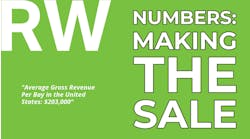Gross profit may be one of the more basic key performance indicators for any business, not just auto repair, but that doesn’t mean it’s immune from being misunderstood.
In fact, from the work that Dave Schedin has done with shops across the country with his company, Computrek Consulting, it remains a source of ire for shop owners.
“A lot of people have a misunderstanding of gross profit,” he says. “It all comes down to personal belief system.”
That personal belief system just might be holding you back from achieving maximum profitability, which Schedin steadfastly believes every shop owner deserves to achieve. He breaks down five ways to improve this all-to-important metric, from your mindset to your software tracking.
Re-examine your belief system.
Many shop owners have a misunderstanding of gross profit because of what Schedin refers to as “money programs.”
“Anytime you talk profit, any of that is all related to someone’s understanding of money,” he says. “Is it OK to be profitable? How much is OK or not OK to be profitable? It all comes down to your personal belief system.”
And that’s exactly where Schedin believes that all shop owners need to start. You must get clear with yourself about what is legitimate to charge: what’s a good profit, what’s gouging, and what’s underpricing.
“It’s most tied to fear than anything else,” he says. “That’d be stealing from the customer or ripping them off.’ That’s not necessarily true; that’s just their own belief system.”
Schedin doesn’t blame shop owners for this line of thinking; in some ways, it’s shaped by society and how we talk about money. But regardless, he firmly believes that you won’t get anywhere raising your profits if you don’t have the self-confidence to do so.
“Here’s my experience with every shop that reaches its glass ceiling: every glass ceiling is someone else’s ground floor,” he says. “Our industry is just now starting to understand it’s not just how to make a shop profitable. It’s the personal development to charge accordingly.”
Strengthen your value proposition.
It doesn’t just come down to our own personal beliefs about pricing, however, Schedin says; it also comes down to the customers’.
“There’s a misunderstanding that when a customer complains about price, most shop owners think it’s about price. In reality, it’s not,” he says. “When you talk about price, it should be about your value reasoning.”
Tough as it may be to hear, if a customer complains about price, they don’t believe they’re receiving enough value for that price. So, take a look at your value proposition. Did you articulate well—in the customer’s language—in a way that made sense to them?
“You express that quality and value; the value is that you have the best peace of mind possible,” Schedin says. “Whether it’s preventative maintenance or an A-level repair, did they get the quality they assume they are paying for? Customers always expect A-level quality, no matter what they pay.”
You may very well lose customers if you focus on a good gross profit, but the customers you weed out will be those price-shopper customers that aren’t a good fit. Don’t be scared of losing customers, Schedin says.
“There are a lot of customers shop owners have that they should let go because it takes so much effort to sell the simplest thing,” he says. “They always want it lower. It upsets the advisor because they're entering a relationship with a lower-echelon customer.”
Streamline your verbal interface.
The No. 1 system that turns on longstanding cash flow is your verbal interface. Everything else is a system around what was sold, Schedin says. So, consider how your systems are supporting your value expression. Are you using the right verbiage? Do you use a digital vehicle inspection that sends photos and videos? Do you have a customer service representative? Are you relying too heavily on technology to do the selling for you?
That last point is actually an increasing concern for Schedin. Technology supports an effective verbal interface, to be sure, but it shouldn’t replace human interaction.
“I love the digital inspections for speed and expertise,” he says. “What I don’t like about it is it’s relied on too much to do the selling for you.”
Create multiple labor rates.
Here we go, the ultimate secret to improving your gross profit: Raise your prices to get the gross profit you want. Sound too easy? Well, if you’ve followed the first three steps, it shouldn’t be, Schedin says.
“Most shops should have a labor rate closer to $250 rate. It’s hard to do that at less than $150, $175 per hour. You’re always playing catch-up,” he says. “If you’re playing catch-up on technology, you’re going to lose customers because you’re learning on the job.”
He readily acknowledges $250 per hour isn’t realistic for every shop, but that’s why you need multiple labor rates (namely, Schedin says you absolutely need a diagnostic labor rate if you want to be competitive in 2021, but he also suggests a variable labor rate), and why you need to track all the smaller aspects of gross profit to ensure those benchmarks are hit, all of which affects your overall gross profit. Those include:
Labor gross profit: 75-80%
Parts gross profit: 55%
Sublet gross profit, except for towing: 55%
Track on a per technician and advisor basis.
For those looking to hone in even more closely on their gross profit, Schedin recommends tracking the KPI on a per advisor and then later per technician basis, as well. In fact, you can even do this through most point of sale software reports, he says.
“It’s all around gross profit volume on the repair order,” he says. “I’ve had some people that are at benchmarks but they’re still not that profitable. Why? Their car count is low.”
Maybe that means the marketing plan was bad. Or it could be as simple as putting out a cheap coupon and bringing in the wrong type of customers. Marketing affects gross profit, and without looking at it from this perspective, you may miss an issue.
When it comes to tracking per technician, it comes down to the inspection.
“You have opportunity from that,” Schedin says. “Some techs don’t call everything. ‘I’m not going to change that fluid until it turns dark.’ Well, they just forced less gross profit on an RO.”
A repair order should be looked at as a cash flow unit and reviewed accordingly. Closely study the gross profit per hour, the blend of parts versus labor, the labor rate on that RO, and finally, of what it consisted. Preventative maintenance, in particular, should make up three or more lines on roughly 30 percent of all ROs, resulting in a 3-3.5 hours per repair order (HRO) on just preventative maintenance.
“That’s not a sales goal—that’s a vehicle requirement,” Schedin says.



